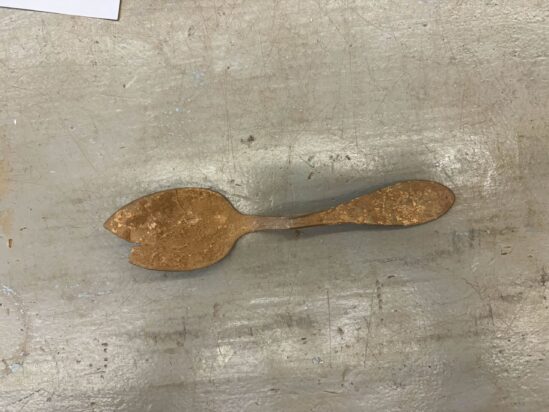Archaeology Blog
2025 Field School Week 6
By: Bethany Byrd and Aurora Summerlin
As all good things must come to an end, this week was the final week of field school here at Poplar Forest. We spent our mornings finishing up our units at the 1857 Slave Dwelling and the Quarter Site. Those at the 1857 Slave Dwelling site were carefully digging and removing a series of features from their layers. We aren’t quite sure what they could be yet, but our theories range from a potential garden, rodent burrows, and old root runs from long-removed trees. It wasn’t a particularly artifact-heavy week, but we still managed to recover nails, ceramics such as stoneware and whiteware, pieces of brick, glass, and more! One unit was able to recover an iron railroad spike on the very last day! Still, every find adds to the bigger picture, even if it raises more questions than it answers. Those at the Quarter Site continued looking for the remains of a potential garden.
Instead of a lab day this week, we spent the full day working on our final projects. We researched a particular topic that each student chose for themselves based on the sites and work we did during field school. The wonderful archaeology team here at Poplar Forest helped us juggle physical data sets of artifacts and other sources for our research (Shoutout to Gail, Poplar Forest’s lovely librarian and historic collections manager!). This helped us develop our research skills and practice creativity and interpretation with our work, but also helped us explore potential subjects that we may be interested in for the future, here at Poplar Forest, or where we may go in the future.
During the afternoon on Wednesday and Thursday, we talked about the next steps we should take after the field school. On Wednesday, we discussed how to look for jobs and internships, how to look for graduate programs and schools that best suit our interests, when and how you should apply to them, and what other opportunities we should look into, like volunteering. On Thursday, we talked about the importance of resumes, curriculum vitae, and cover letters, and how to properly tailor them. Field school isn’t just about learning technical skills for digs but also about how to progress our futures as archaeologists!
On the final day, Friday, we spent the morning in the field doing some finishing touches on our units and explaining to our classmates what we had been doing so far in these units as well. The rest of the day was spent indoors, where we listened to everyone present their final projects. We sat through fourteen different presentations, each one focusing on a unique aspect of this summer’s excavations. A few stood out to us in particular: one about the concentration of fence staples in the southeast corner of the 1857 Slave Dwelling, alongside some barbed wire concentrations in the middle of the trench as seen in spatial distribution patterning, which suggests the possible presence of a fence line or division of space in that area (even though the staples themselves weren’t especially numerous.) Another one on a large, locally-made plow blade recovered near the house was interesting to us because it is such a great example of the story a single plow blade can tell, even if we only know fragments of the full picture. The last one that stood out to us is the presentation on game faunal remains at Poplar Forest, mainly because it reveals some information on three important themes we’ve explored this summer: the changing landscape, the diet of the enslaved people, and their hunting practices.
The week wrapped up our time in the field, and while it was exhausting, it was just as rewarding. Between the dirt, the data, the stories passed down, and the artifacts pulled from the ground, it’s easy to see how archaeology is as much about people as it is about objects. We’ll carry this experience with us long after the paperwork is done, likely for the rest of our lives.



